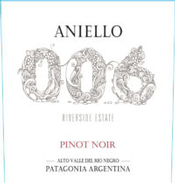 one region, Mendoza, dominates production with 70 percent of vineyard plantings and also claims nearly exclusive consumer recognition, Patagonia offers an exotic alternative of cool climate wine style.
one region, Mendoza, dominates production with 70 percent of vineyard plantings and also claims nearly exclusive consumer recognition, Patagonia offers an exotic alternative of cool climate wine style.
Patagonia is actually a huge area made up of four provinces, Neuquén, Rio Negro, La Pampa, and Chubut. The latter two areas are still frontiers for Argentine winemakers, and Neuquén is also a relatively new area. The original vine growing area of Patagonia, and its first GI (Geographic Indication), is Rio Negro, where the small Aniello estate is situated. The Rio Negro wine district in fact has two parts, the Upper Rio Negro Valley where vineyards stretch along both sides of the river and a smaller, less significant vineyard area near to the coast.
By Argentine standards, Rio Negro is not high in altitude. The region’s southerly latitude, however, is key in creating a cool climate with long sunlight hours and significant diurnal temperature shifts, factors that bring ripeness and yet freshness to the wines. Aniello’s 006 Estate, for example, sits at 39° S latitude and 1,100 feet altitude. (Five years ago, Aniello purchased another estate, which it calls “341.”)
Rio Negro is not such a cool area that it produces only classic cool-climate wines, but in a tasting that included Aniello 2017 Malbec and 2017 Chardonnay, it was the classic cool-climate Pinot Noir that impressed me most. It is a fresh, vibrant, medium-bodied Pinot Noir of a sort that is very uncommon at this inexpensive ($17) price.
The 2017 Aniello “006” Pinot Noir has aromas of cranberry, strawberry and red cherry along with hints of wild herbs and flowers. In your mouth it is truly dry, with crisp acidity and just a moderate amount of spicy tannins that do not distract from the fruit. Flavors, like the aromas, skew toward red berries with a slight dry-earth complexity, and they show good concentration. Despite its smooth texture, the wine is lively and energetic.
Winemaking for this Pinot Noir involved a pre-fermentation cold soak to extract flavor. Fermentation took place in small concrete tanks with 30 percent whole cluster included, a technique that enhances freshness and flavor expression. Thirty percent of the wine aged in French oak for twelve months, but judging by the wine’s taste, that oak was not new.
In its relative lightness of body and its vibrancy of expression, this wine represents the sort of Pinot Noir that can easily swing from situations, or dishes, that call for white wine to those that favor red wine.
90 Points
